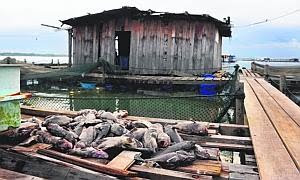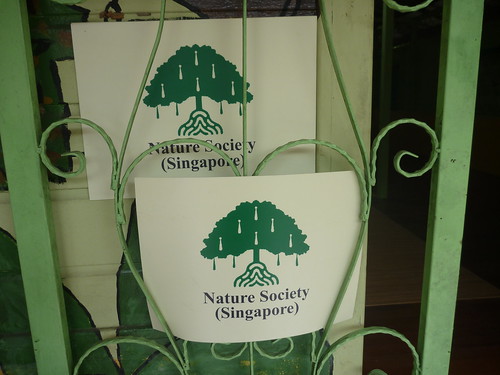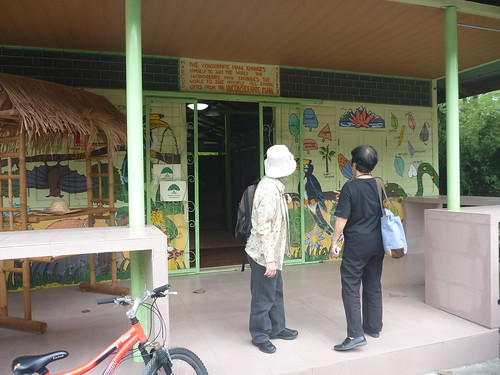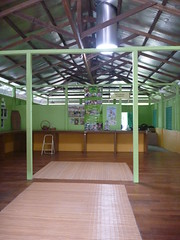Recently it's hit the news that
massive algal bloom, also known as
red tide, has affected the waters surrounding Pulau Ubin, Changi and Pasir Ris. There are several ways in which harmful algal bloom could cause mortality in marine organisms. According to
Wikipedia's entry on algal bloom, these include:
1. the production of neurotoxins which cause mass mortalities in fish, seabirds and marine mammals
2. mechanical damage to other organisms, such as disruption of epithelial gill tissues in fish, resulting in asphyxiation
3. oxygen depletion of the water column (hypoxia or anoxia) from cellular respiration and bacterial degradation
Human consumption of seafood which has been affected by these algal bloom can also be potentially deadly. Seafood lovers, do take note!
As we know, large number of fish farms have been established in recent years by AVA in the straits of johor near Pulau Ubin. This red tide has also hit the fish farm resulting in large losses. Although reports in the news points to oxygen depletion, I wonder if there are possibilities of neurotoxins in the water or mechanical damages as pointed out earlier. As reported in the
Wild shore of Singapore and
God's wonderful creations, non-fish marine organism have remained unaffected.
 Photo by Caroline Chia, Straits Times, "Plankton bloom hits Pulau Ubin fish farms"
Photo by Caroline Chia, Straits Times, "Plankton bloom hits Pulau Ubin fish farms"Interestingly, some farmers would quoted to have "pumped seawater from greater depths to the surface to aerate the water there, and lowering nets so the fish swim in the more oxygen-rich water lying deeper in the ocean." However, the upwelling of seawater would also bring up the nutrients that usually lie at the bottom. Could this have fed more nutrients for algal growth?
Further on
wikipedia, in occasions of hypoxia (or a depletion of oxygen in water), "fish kills can occur and invertebrates like worms and clams on the bottom may be killed as well." Crustaceans like crabs and shrimp would also be found dead. So far I have yet to read reports of dead crustacea or has any one spotted some? There could also be death not washed ashore. A healthy aquatic environment should have 80% dissolved oxygen and most fish cannot live with only less than 30% oxygen dissolved in the water.
There are also natural occurrences of oxygen depletion:
"Water flowing from a river into the sea is less dense than salt water. When this water does not mix with the underlying saline water, it sets up a stratification that results a decrease in vertical mixing. As a result, there is less supply of oxygen from the surface to the bottom, and the oxygen concentration in the bottom layer may become low enough for hypoxia to occur. Hypoxia is particularly problematic in shallow waters of semi-enclosed bodies of water like the Waddenzee or the Gulf of Mexico where land runoff is substantial. In these areas, a so-called "dead zone" can be created."
Interestingly, our straits of johor is relatively stagnant due to the presence of the causeway blocking off circulations in our straits. But Ubin being closer to the sea and to the mouth of Johor River, it is more likely that AVA's report of high freshwater discharge from monsoon storms into the sea could have caused this "natural" occurrence. The freshwater discharge "floats" on top of the saltwater. In this case the water at the bottom has less oxygen so for the fish farmers to lower their fish into the bottom or for them to bring water from the bottom to the top seems to defeat the purpose.
Let's just hope that this does not become a permanent dead zone. According to wikipedia's section on "
solutions for hypoxia", it would appear that "air injection" rather than "pumping seawater to the surface" for "aeration" would do a better job.
If nothing else, let's hope that this incident would not result in another
2007 chek jawa mass mortality due to johore flood waters. It's amazing how the same excessive freshwater would result in such different events just 2 years apart. In fact, every year we suffer from similar monsoon freshwater discharges into our straits but why such a reaction this time round? Or could it be that we never noticed before due to the lack of fish farm with thousands of reared fish vulnerable to these natural changes? Perhaps when we situate our aquaculture facilities, we never took into consideration these seasonal fluctuations? Perhaps it's time we start! Most importantly, it's important that these human interferences such as aquaculture fish farms do not exacerbate the problem and result in negative impact on our already vulnerable marine ecosystems and wild population of marine life. Fingers crossed, nature will find its own equilibrium and return our waters back to normalcy soon!
Below are related news report:"
Fish farms in west spared from plankton woes", Irene Tham, Straits Times 3 Jan 10
"
Plankton bloom hits Pulau Ubin fish farms" Melissa Sim, Straits Times 2 Jan 10
"
200,000 fish in farms off Pasir Ris dead", Carolyn Quek & Jessica Lim, Straits Times 1 Jan 10
"
Johor fishermen cry foul over dead fishes", Moh Farhaan Shah, The Star 1 Jan 10
"
Dead fish on Pasir Ris beach", Straits Times 29 Dec 09
Ria Tan of WildSingapore offers her take on the situation:"Dead fish zone" hits Pulau Ubin, 2 Jan 2010, Wild shores of Singapore
Why are there so many dead fish on Pasir Ris, 30 Dec 2009, Wild shores of Singapore
A closer look at dead fish found on Pasir Ris, 30 Dec 2009, Wild shores of Singapore
Dead fish at Pasir Ris, 29 Dec 2009, Wild shores of Singapore







